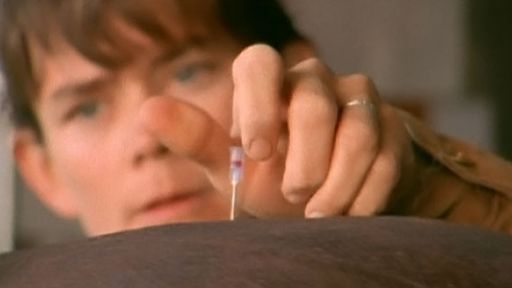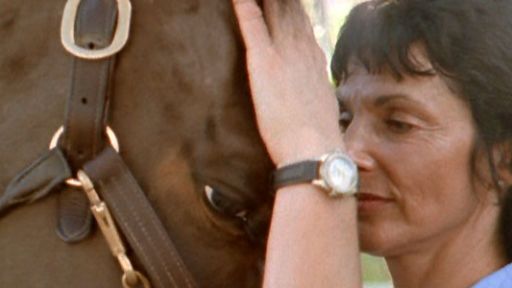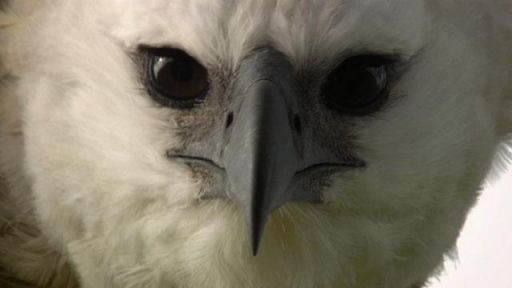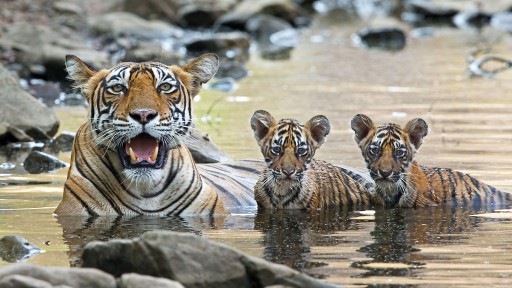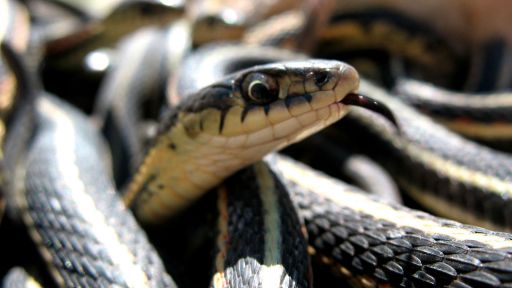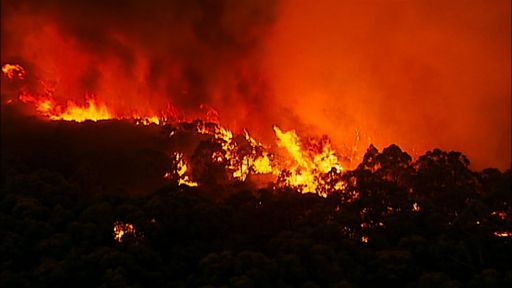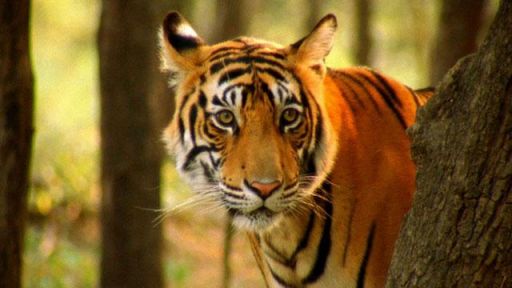TRANSCRIPT
[solo horn] [mellow music] - [Victoria] You have to be able to let them know that they can trust you, and you're not gonna try to eat them, like everything else in the wild, right?
- [Child] I like horses.
- [Victoria] You don't like to eat horses?
Me neither, but they don't know that.
- [Lindy] All the way, that-a girl.
A little too much left leg going back across.
You're gonna cut that cow off from the rest of the herd.
[upbeat guitar] Stay up on that cow now, don't quit her, now.
A good cutting horse firing on all cylinders with a rider that's firing on all cylinders; that's hard to beat.
[audience cheers] [mellow music] - [Adam] My challenges are to have the horse playing the level of a champion, and that's what allows me to play at that level.
Just trying to sharpen her up, just trying to get her on her toes, getting ready to jump out, ready to stop, listening to me.
[audience cheering on players] [upbeat music] - [Jane] Give it another try.
Okay, yeah, we know that we hit a nerve there.
When you're really in tune with the spirit, with the soul of the horse, and you're working together, there is this feeling of oneness.
The rest of the world goes away.
[calming music] [mellow chimes] The horse is a creature of flight.
It's what has allowed them to survive as a species.
Horses are also herd animals, and the horse feels protected.
[relaxing music] The horse and rider make up a two-person herd.
And one of the most intriguing things is being part of their world, but as a partnership.
[background chatter] - [Lindy] In cutting, the horse and the rider work together, but it's the horse that leads.
The horse has to read the cow, and keep the cow away from the herd, anticipating its every move.
The rider's got the best seat in the house, but it's a horse that calls the shots.
[audience applauds] [galloping hoof beats] - [Adam] Polo ponies are the most incredible equine athletes, because you're asking them to run 30 miles-an-hour, like a race horse.
And you're asking them to stop and turn like a cutting horse.
- [Jane] A flawless dressage ride gives the appearance that the rider is doing absolutely nothing, and the horse is doing it all of his own volition.
But there's a whole lot happening bubbling beneath the surface.
It's really a mutual collaboration between horse and rider.
The end result appears as if there's two bodies, but one mind.
[calm acoustic guitar] - [Lindy] I'm Lindy Burch, I'm a professional cutting horse trainer, breeder of quarter horses.
I develop and train horses for showing, competition, as well as selling.
I live in Weatherford, Texas.
I have 160 acres that I train the horses out of, raise them, and conduct my business.
Horses are clearly my life.
I figure out who I wanna breed my mares to, I raise the babies.
Some of them I still have at 10 and 15 years old that I've raised, competed on, and kept to maybe to breed, or maybe just because they're my best friends.
In a great cutting horse, breeding plays, you know, an awful lot in that, in the genetics.
It's a heritable trait that horses work cattle.
I love to go out and just watch 'em.
What I look for is the playfulness in 'em.
A couple of them are coughing just a little bit.
[uplifting music] Jay's baby looks really nice.
Go on, kids, go on, kids.
They exhibit a lot of the movements and a lot of the curiosity as a young horse in a free situation, out in the pasture, that I want them to emulate later as a competitive cutting horse.
[uplifting music] Yeah, you can turn her now.
When foals are born at my place, I like to imprint a little bit, I'll go in and hold them, and pet 'em, and touch 'em all over.
I don't want them to ever fear a human.
I want 'em to just accept people just the same as they accept another colt.
So they get quite a lot of human contact.
He's getting a little grain.
And then when something new is introduced, like the camera, or new people walk into the pasture, all of a sudden those colts, just like a magnet, they go, "Wow, look, there's something new."
They're just like little kids in here.
They come, and they're unafraid, because they've never been hurt, and they've never been chased.
And they've only been petted, and talked to, and fed.
And I think they're just so curious, because they are really intelligent, but I'm certainly breeding for that.
And the best cutting horses are the most intelligent.
[horses snort] You know, it's easy to explain cutting, really.
The essence of cutting is the competition between a cow and horse, is how I describe it.
Cattle are naturally herd animals, and they feel very good in a herd, and very secure in a herd.
In cutting, you drive one cow away from the other cattle, that cow that you've separated is gonna want to return to the herd.
So therein lies the competition, the cutting horse counters that cow's moves as she tries to return to the herd.
[cows bellow] What I do normally every day is train horses.
Now within that, I will take some students on.
What we usually call "non-professionals" that want to get a little better, want a little more expertise and more practice.
Is a move that I try to control that cow from- I try to get 'em on their horse as soon as I can, before they get too bored.
And if you do, you don't want him wondering which cow he's gonna take.
'Cause my job, my responsibility as a rider, is to show which cow I'm gonna cut, help him get that cow cut, and then drop my hand.
All the way, whoa, just stop him, whoa.
Okay, let's try it again.
Tara was a first time cutter, she's a good rider, but she really doesn't have much knowledge of cattle.
When I got her on her horse, her first view cuts were a little rough, and she was a little bit out of sync.
Little bit, leg, let, leg, there you go, Tara.
Little more, little more.
[cows mooing] That-a girl, all the across.
Then she started getting in proper position, trusting the horse, and it started working a lot better.
And then she got the feel, and the big smile came on her face, and she didn't have to do near as much work as she thought she had to in the beginning.
There you go, all the way across.
Good!
All right, let's cut another cow, put him right there.
Chris has ridden a lot, he's a young trainer.
In Chris's case, he tries to ride and dictate to his mounts what to do too much of the time.
That's all right.
She needed to get stopped.
So I'm able to say, soften up, slow down.
Let that horse think a little bit.
If you've got, if you keep telling her to do something that cow's not, she's gonna say, "Well, I better pay attention to Chris up here and not that cow."
- Right.
- And we want 'em drilled on that cow, and have all that intensity channeled to the cow- - Sure.
- not to the rider.
The rider is just a reinforcement.
Just take your time, try to be smooth.
That's right, that-a boy, that's it.
Try to be smooth.
[honky-tonk music] There you go, excellent.
In your image, now.
Stay in your image, perfect.
Excellent.
Good.
Bet Yer Blue Boons is my best cutting horse.
I call her Bet, and she's won over $300,000 in competition.
She's in the Cutting Horse Hall of Fame, and this year we're competing for the World Championship.
I don't work her very often, I don't need to.
My major responsibility with Bet is just to keep her in shape, so she doesn't hurt herself when she does compete.
If I'm having a bad day, and I want a real rush, then I get Bet out, because she's as close to perfect as I've achieved.
[country rock music] [flutes playing] - [Jane] Oh, good boy.
My name is Jane Savoie, and I'm a dressage rider.
I am based part of the year in Stratford, Vermont, and the other part of the year, the other six months in Wellington, Florida.
I train, I teach, I write.
And I also coached some dressage and three-day event riders at the Olympics in Sydney in 2000.
This is Conetta, and I call her Netta for short.
She came from Europe.
She had a very bad beginning in Europe, she was mistreated.
And we started developing our relationship about a year-and-a-half ago.
The word "dressage" actually means training, and what we're doing to bring the horse from the most basic level, to the Olympic level, takes approximately four to six years.
Yep, target.
Once she touches that target with her nose, she gets a click, and she comes back for her reward.
Good girl.
She really associates the sound of the click with the food reward, so I can reward her continuously throughout the process.
Target.
Target.
Good girl.
Target.
She didn't quite touch it, she's gonna come back for a food reward.
I'm not gonna give her a food reward.
She got close to the target, but she didn't quite touch it.
Target.
[laughs] Target.
She touch it?
- Yep.
[clicking] - [Jane] Good girl.
Good girl.
Close is not good enough, she has to touch the target.
The history of dressages was basically a sort of a military-type background, where horses were used in battle, and they needed to be able to turn on a dime.
And they needed to be able to charge forward when the warriors asked them to do so.
The movements that horses were required to do are actually all natural movements.
They're movements of play, they're movements of exuberance.
The trick is to do them on cue by the rider.
Good boy.
Historically, Netta has been abused with the whip.
So before I could use the whip as a tool, I had to help her overcome her fear.
[clicks] Good girl.
Yes, you're a very good girl.
I think of the raw horse, who's just starting as a lump of clay.
And through the gymnastic exercises that I do with the horse, I can mold and reshape the muscles so that the horse actually becomes more beautiful.
Good girl.
And whereas a race horse is built for speed, the dressage horse is more like a bodybuilder.
Super in her neck, more, needs more.
Yeah, yeah, good.
Good girl.
And very, didn't look wide behind at all, did it- - No.
- from your angle?
- No.
- Good girl, Netty.
What a best horse.
A rider can be no better than the horse that she's sitting on.
So it's really a mutual collaboration between horse and rider, to end up with the finished product that shows you that beauty, just like looking at a beautiful painting.
Good.
Good.
Yeah.
[clicks] [whimsical music] - [Adam] My name is Adam Snow, and I'm a professional polo player.
I'm also a father, and a husband, and a horse trainer.
I am constantly striving to get the best out of the horses and the best out of myself.
- My name is Shelley Onderdonk, and I'm a veterinarian.
I work almost exclusively with horses.
And Adam and I moved to Aiken about three years ago, and we bought this farm.
- [Adam] What kind of drills do you want to do today?
- [Shelley] I'd like to try to do them going side-by-side like we were practicing the other day.
- Yeah.
- Cantering side-by-side.
- [Adam] Yeah.
- [Shelley] And maybe even trying a little bit of touching.
This is Beach Bum.
Good girl.
She's a three-year-old from Wyoming.
- [Adam] My hopes are that she'll be a great high goal polo pony.
- [Shelley] Trying to get the horses used to just being right next to each other, and not letting it bother them.
- [Adam] Having interaction with the other rider.
This is a great drill.
- [Shelley] Good girl.
- [Adam] The more work we can do with her interacting at close quarters with another horse, meeting, bumping, rubbing, the more she's gonna start to understand that she can carry herself with confidence, even on a field with a lot going on.
[horse whinnies] - [Shelley] That's a good girl.
Okay.
That's no big deal.
- [Adam] Can do counter-circles here, Shel.
- [Shelley] Okay.
- [Adam] You want to go on the inside?
- [Shelley] This is fine.
When we're meeting, every time she passes another horse, she puts her ears back, which is a big improvement.
She used to buck, or spook, or take off.
And now she's just kind of putting her ears back.
- [Adam] Can keep the circle small right here.
- [Shelley] Okay, good girl.
- [Adam] She's settling in.
- Yeah.
See her ears go back every time I met you?
But her body didn't react, it's just her ears.
- [Adam] Come over and brush me once in a while.
[horse snorts] - [Shelley] What's that, huh?
- [Adam] Just rub her with it- - What's that?
- on her neck and stuff.
- [Shelley] Okay.
- I can hold her.
- Okay?
- [Adam] Yeah, she doesn't seem too upset about it at all.
- No.
- [Adam] And she's still getting her used to a stick and a mallet, getting her comfortable with a mallet swinging around her head and following a ball around.
- [Shelley] Good girl, yeah.
Horses, in nature, live in herds.
It's very important for them to have relationships with other horses.
[uplifting music] And so polo's a very natural sport, in some ways for the horses, because it is a team sport.
And so they're not asked to perform solo.
One of the things that reinforces the herd instinct is following the play.
A horse wants to run after a horse that's running in front of him.
What is more unnatural are things like meeting traffic.
It's very difficult for a horse to have horses galloping at it, and continue to go through an opening that it may see.
[foreign language] From the time I was little, I've always liked to be around horses, it makes me happy.
I'm in a better mood at the end of the day if I've been around horses for a while, because I'm able to care for something and help something.
[Shelley speaks foreign language] [in English] Polo ponies are high-performance animals, and they put a lot of stress on their bones, and their tendons, and their ligaments, and their joints.
And what I like to try to do with Adam's horses is practice entirely preventative medicine.
And of course, that's an ideal, because horses get injuries and whatever.
So when he's playing a string of horses in high-goal competition, for example, I will be at the barn checking every single horse once or twice a week.
She's got a little bit of soreness through her back and her hindquarters.
From my particular perspective, acupuncture is a wonderful compliment to traditional medicine.
It's like having another tool that I can use, to both diagnose and treat horses.
Depending on the particular problems a horse may have, I might use Western medicine, I might use acupuncture, I might use both; I often use both.
I think that you can establish a lot of rapport with a horse, by knowing the points to touch, that's just the tactile sensation that they appreciate.
- [Auctioneer On Speaker] 10, 11, 10, 11 played all summer.
[indistinct] - [Adam] We're at the first annual polo pony auction in Aiken, South Carolina.
And there's about 140 polo ponies from across the nation.
[Auctioneer speaks rapidly] - [Adam] I'm always searching to upgrade my strings of horses that I own.
Wow, she's a chunk.
She's a chunk.
Truthfully, there's no generic best polo pony.
And so I'm trying to look for the horse that Adam Snow loves to play.
Is she- - Very kind, yeah.
Very kind.
Very sound, healthy, she is a tank.
- Yeah.
- [Mack] Just needs to finish off the right guy, and then she's gonna be set.
And that'll happen within the next seven or eight months.
- Right, okay.
- You know, she's a really nice mare.
- Okay.
- [Mack] But right now she's a lot of fun, 'cause she's got, looks like a quarter horse.
- [Adam] She looks that way and I can't see...
I'm gonna take one more peek to see if I can... - I mean, you got, you can go anywhere you wanna go with her, you know?
I mean, she's ready to go to a guy like you, she's ready.
- Well, I hope that I can get her.
- Well, I would love it.
- [Adam] Can I just see her straight walk away, down the aisle and straight walk back?
Buying Bonnie was an important event for me, and I purchased her for $35,000.
She's, big bodied, solid, and I really like when they have a lot of breath between my legs, which she does.
The two or three-year plan with a mare like that is that she has a crack as one of my best horses.
And that's what I'm hoping Bonnie will do for me in 2002.
She was sure fun to ride.
- Right now is where, you know, it's the fun time.
- It'd be great.
- All right, see you, Mack.
[joyous music] - [Jane] Ruth and I started working together when she was about 14 years old, that's over 20 years.
- [Ruth] Now, make sure it's not pushing the hindquarters out, it's engaging... - [Jane] Ruth's such a gifted trainer, her priority is to relate to them, in terms of how they're thinking and how they're feeling, rather than imposing her thoughts and her will on the horse.
- [Ruth] He likes to carry weight on his left hind-leg like that, but it's a good test for you, because when you go...
This is Chamont, he's an elderly horse that I adopted about a year-and-a-half ago.
He came to me with a lot of anxiety problems and some insecurities that I decided to take on as a personal challenge of my own, to see where we could go.
- [Jane] Okay, so here's what I'd like to work on now.
We know that he's quite comfortable, as far as doing a very easy piaffe.
But since he has such a background, such a history of psychologically freaking out... - [Ruth] Well, this horse knows, actually, all of the movements.
So what I spend most of my time on are really comforting him and keeping him mentally confident, so that his surroundings don't upset him.
- [Jane] What we wanna do next is turn up the volume a little bit, turn up the pressure, just in increments.
We do everything very gradually and by degree.
So you're just gonna gradually apply a little more pressure.
And the reason you're giving him more pressure is to ask him to step a little bit higher with all of his legs.
And let's see if he can cope with that mentally.
Okay, yeah, that's fine, that's fine.
We know that we hit a nerve there, so you're just gonna sit very quietly, that's right.
And that's right, and praising him, and telling him, reassuring him, telling him he does not have to be afraid.
[Chamont snorts] And let's try that again, stepping up the pressure a little bit.
Yeah, yeah, yeah.
Good, good.
And a little bit more, see if you can get him to bend his legs a little more.
Yeah, very good, and walk and pet him.
Yeah, super, Ruth, really, really nice.
Every time you have a discussion like that with him, and he loses it emotionally and he comes back to you, you're developing his trust level, his confidence level in you, more and more and more.
So that eventually he can deal with more pressure, new situations.
Like when we take him to the competition in February, that he realizes that things can scare him, but he's not gonna be punished and he's not gonna die.
And in fact, if he stays home mentally and listens to you, and stays with you as a partner, things will actually get better.
- [Ruth] Good.
- Okay?
That was great.
- [Lindy] I think the affinity between some horses and people is kind of a natural thing.
I think horses like to be treated well, and they respond when they are a smart horse does.
I just like being around them.
I think I identify a lot better with horses than I do, sometimes, a lot of people, because they're real honest.
What you see is what you get, you do something to them, they respond.
I don't know, I just, I like the relationship.
[announcer in background] Steamboat Springs, Colorado, this is the Derby Classic.
It's a big open show, in terms of cutting horse competitions.
It's important to enter as many shows as I can throughout the year, because the money in the purses of all these shows add up.
And the team, meaning the horse and the rider, the most money at the end of the year, wins a world championship.
The world championship is a title that I've never really committed to before.
Bet Yer Blue Boons, my best cutting horse, set a world record at the Houston World Championship Finals two years ago.
If you ask 10 people what makes Bet the best cutting horse, most of them would say, "She has such an amazing stop."
She still can stop hard, and turn with the cow quicker than any horse I've ever seen.
Now she's 10, she has lots of experience, and she's just getting better with age, she's like fine wine.
She really likes the competition, she really likes to work cattle.
And at a show, she kind of just seems to step up a notch.
[twangy country music] She just knows her job, you know, and that she doesn't sweat the small stuff.
[audience cheers] [slow acoustic guitar] What's really special about cutting, and very unique from any other equine discipline, is that in cutting, the horse actually thinks.
A cutting horse has to work a cow, which is a living, breathing animal.
And the horse has to read what that cow's doing, and why it's such a special relationship with the horse and the rider.
I get to sit there and reinforce what that cow does, what that cow tells my horse to do, she reacts and makes the counter moves.
I don't tell her, "Now you have to go left, now you have to stop, now you have to go right."
If I raise my hand, it's a penalty if I reign her, or visibly cue her in any way.
So it's like a dance in motion, between the cow and the horse.
[audience cheers] [buzzer] [audience cheers] Today, here at Steambook Springs, you know, she was on, really on.
So, you know, we were able to have a really good run.
The paycheck we received today, it means a great deal.
In the years, total, every penny counts, as far as the top 10 horses.
[indigenous music] - [Adam] This mare's name is Rio, she's a five-year-old polo pony that we've had since she was two.
And I am trying to improve her, to hopefully play top polo on in Florida.
[joyous indigenous music] Some of the most important characteristics of a great polo pony are that they're quick and they're easy.
They need to change directions like that, they need to be ready to run, and ready to stop.
Whew.
[laughs] [breathes heavily] Need a second to catch my breath.
I was trying to sharpen her up, I was trying to get her on her toes.
Getting ready to jump out, ready to stop, listening to me.
She's got so much natural ability that she can put it together, she's gonna be awesome.
But she's got a real lazy streak, and it requires pushing her hard.
Takes two years, generally, to train a polo pony at this age, three or four.
My hopes are that she'll be one of the, my really good ponies in Florida, I'll take about 14 horses down.
I hope to give her her first experience of the best level of polo that's played in this country.
Then how good she is, is for her to decide.
I played Rio since she was three years old.
And I waited until now she's six to actually bring her to Florida.
And I can really say that she's practiced consistently very, very well.
The first match that I played her, she had a terrific chukker, played a full seven minutes, was tired, she never played that speed before.
But she was one of my three or four best chukkers of that game.
The only thing that she's still showing sometimes, a lack of experience, is when somebody will pin up with me in a bump.
She doesn't always want to push through that bump.
And that's when I feel her lack of life on occasion.
[audience cheering] Polo is a sport, like ice hockey or soccer, on horseback.
There's four players on a team, two goalposts at either end of a field that's 10 times the area of a football field.
Polo is a handicap sport, and the best players in the world are rated 10 goals.
And my handicap is 9, my goal is to be a 10-goal player.
[birds chirping] - [Jane] Very good, Ruth.
And good through the base of his neck there.
Over the last couple of months, we've made great strides in developing his confidence.
Yeah, good girl.
And then tomorrow at the show, you can bring him up.
Good, super, well done.
When he has his meltdowns, they're minor, and Ruth is able to work through them much more quickly.
He's just been making great strides, and we're looking forward to tomorrow.
Good in the neck, good in the neck.
Super.
- [Ruth] I don't know what I'm gonna get, from one horse show to the next.
Last horse show I upped my score 11 percentage points, which is huge.
If I can up my score even two percentage points this time, I'll be very happy.
- [Jane] Put his neck in and his body in.
Tomorrow at the competition, to make the pirouette polite, that's your goal.
- [Announcer] The opener at Wellington just two weeks ago, [indistinct] two classes on the first of the days in the first show.
- [Jane] So far.
Good.
Do you need water, did you drink something?
- [Ruth] I took some, yeah.
Yeah, that'd be great.
- [Jane] Little sugar?
Spoon full of sugar?
He's looking really confident, really secure, which is the major issue for this horse, because he gets frightened so easily.
So it looks like it's gonna be a good ride, but you never know when you're showing horses, right?
- [Ruth] Yeah.
- [Jane] Get over there.
This particular show represents her evolution as a trainer, that she can take a very, very difficult horse, and do with him what no other professional has been able to do.
And get him confident enough that he can go down the center line and perform.
- [Announcer] And down the center line now for the Intermediare 2, here is Ruth Hogan Polson, Number 193.
- [Jane] Well, I'm really excited, because she's had a super warm-up.
[quirky music] This is a surprise, this first halt and threatening, but Ruth is being very quiet and very tactful, calming him down, and they're proceeding as if nothing happened.
In fact, if the judge blinked, he would've missed it.
This is really going quite well, because I like the overall shape, and frame, and the balance of the horse.
This is much better than what he's been doing in schooling.
He's holding his outline, his silhouette, so that it's a correct outline for a horse at this level, which is almost the Olympic level.
So, so far, so fair, this is going quite well.
[quirky music] [Chamont snorts] Oh, now we're getting into a little bit of a problem here.
He's once again, he's threatening, but she reassures him.
And so it's just a moment in time, and then she proceeds as if nothing happened.
That's what's so terrific about Ruth.
When these little errors or faults happen, which could be totally disconcerting for another rider, she's able to stay focused and ride in a proactive, rather than a reactive state.
[quirky music] There were some things that I really, really liked, like the general outline and frame of the horse, it was very, very good.
I liked the way she handled his moments of hysteria.
I don't think anybody could have done it any better than the way that she did it.
She did have some technical errors, even though some of the work was very, very high quality, the judges have to deduct points when you make technical errors.
So the overall score is not as high as it could have been.
- [Announcer] In the Intermediare 2, Ruth Hogan Polson... - [Jane] What was that about?
One of the things that we learn from horses, as our teachers, is how to be humble.
Because just about the time you think you're pretty hot stuff, and you're a pretty good rider, and a pretty good trainer, your horse will find a way to humble you.
You weren't getting it.
Really good in the general outline and frame, too bad about the mistakes.
What a real horsewoman or horseman learns is that it's not about you, it's not about how good of a rider you are, it's always about the horse.
[background chatter] - [Adam] Florida is the high-goal mecca of polo in this country.
And really my entire year is training for the three to four-month season that I play down here.
- [Announcer] Ready to go, and it's three goals to zero.
- [Adam] This is where it's at, this is the best professional polo played anywhere in the world.
It has all the best players from Argentina, from Mexico, America, New Zealand, Australia.
It brings the best horses from all over the world, and it's really where you make it.
- [Shelley] Rio, that's all right.
Well, Rio's clear today.
It's not showing any reactivity on any meridian or acupuncture points.
And which is great, because about 10 days ago, a week to 10 days ago, she, after a game in which she didn't play very well, she was very, very sore.
And so we treated her then, and we gave her some time off, and we have her on some medicine.
And now she's doing much, much better.
And she'll be playing in the game tomorrow.
[birds chirping] [background chatter] - [Adam] To have a chance to win any tournament in the world, a player needs to be well mounted.
[whistle blows] [audience cheers] I think that the horse is 80, 90% of the game for me.
So when I'm going into a game, I'm not only preparing Adam Snow, but I'm preparing one of my top ponies.
[audience cheers] I usually bring about eight horses to a given match.
Some people say, "Well, seven minutes doesn't sound like that long," but it's a lot to ask of them.
[funky music] - [Shelley] Rio's training has progressed exactly how you would like a polo pony to progress.
She has a frame that you can spot, even if it's 300 yards away, her neck and her head are relaxed.
She's therefore able to use her muscles to their fullest capacity and power.
[funky music] - [Adam] The best pony will be one that's still got its ears twitching, listening, "What do you want, what do you want?
You know, are we stopping, are we running?"
They have to be listening to me as a rider, through every situation.
[funky music] - [Player] Well done, Adam!
- [Adam] It was a scramble in the end, but fortunately we kept our cool, and got a couple good goals in the sixth and came through.
And I was thrilled with Rio.
Thank you.
Rio was awesome.
And today she came back with everything she had, and it was probably the best chukker she's ever given to me.
So she'll get to go home to Aiken, and have a little R&R, and kick up again in the summer.
[birds chirping] - [Announcer] Wendy is showing an 11-year-old mare that is sired by... - [Lindy] I'm not nervous, but I'm pretty focused.
Because you know, eight years is culminating tonight.
If I don't mess up, and we win the world championship, that would be the greatest honor that she could attain.
So I really didn't wanna mess this up for this mare, because I felt that she really deserved it.
[Announcer in background] [audience cheers] This cow is great, she comes to Bet, and Bet's on her rear-end.
Even though the ground is so deep, and it was bothering a lot of the horses, it didn't bother Bet.
You know, at 11 years old now, she's such a trooper and so competitive, that, you know, she just took it in stride.
[audience cheers] I know I've got a really good run started here.
So I have to slow everything back down, find my other cow, and then get it cut, clean.
[cows moo] The clock's ticking, and I know I just have to not make a mistake for about another minute here, and get this black cow cut and drop her down.
And she's certainly showing a high degree of challenge here, and Bet meets her on every step.
[audience cheers] [audience applauds] I try to get her cut out here in the middle of the pen, give a little time for Bet to catch her air, but not a whole lot.
We get this cow cut, and there's about 16 seconds left.
I drop her down and it's a great cow, and she just smothers this cow.
[audience cheers] [buzzer] I hear the buzzer and right there, I know we've won the world championship.
[audience cheers] [audience cheers loudly] My earliest recollection of a horse is sitting in front of my dad in the saddle, riding his horse with him.
I don't remember talking, I remember horses before I remember talking, if that that makes any sense.
[heartwarming music] I'd get up while it was still dark, in the summer, and go get on my horse.
And normally I'd be gone till dark, and I would just ride.
I just love to ride, I still love to ride.
- [Jane] Michael's looking straight ahead.
You see a lot of people that don't know anything about horses.
They think, "Well, gosh, you know, they weigh 1,200 pounds, and only I weigh 100 pounds."
But if you're gonna go rent a horse for an hour on Sunday afternoon and go ride it, you have to build a relationship.
Your turn.
[kids giggle] - [Keri] You're okay, come on, come on.
You can do it, come on, come here.
I'll do it with you here, come here, take your hand.
Go like this.
That's all you have to do.
You just have to let him know that you're going behind so you don't startle him.
- The kids learn so many things about working with the horses.
One of the things is their communication skills.
Their body language is a communication skill.
You know, the horses start to react to their body language.
So we teach 'em to communicate with the horse, by using as many avenues of gentle communication as we can.
- There you go.
- I can't.
- [Keri] Swing your leg over, swing it over.
You'll be fine, I promise.
Your hands, just here, take your pinky out.
Just the slope of his withers.
Then I want you to show me how you can make him stop.
Good, now ask him to stop.
And now say ho.
- Ho.
[giggles] - [Keri] Oh perfect, see, you can do it.
So hang on tight and just sit there, okay?
Oh my God, for the girl that didn't wanna lead the horse out, you're doing excellent.
- [Jane] I think more than anything, I want them to work in the realm where they're comfortable with the horse, and leave with an increased self-confidence, realizing the horse wants to do what you want him to do.
And if you're gentle, you get what you want out of that animal.
- Would you like me to lead you, or do you wanna go on your own?
- On my own.
- [Keri] You wanna go on your own?
Okay.
- Our horses really are a mirror of ourselves, not only on a day-to-day basis, but in the big picture of where you are in your life.
A horse will always be honest with you, will always tell you exactly how he's feeling about you.
- What I think's important for me, as a rider, is to develop a relationship with that horse based on trust.
And I never try to ask a horse something that it's gonna be scared by.
But in every stage of their journey, from being a skittish little foal, to being a top polo pony, it's always trust that I go back to.
[uplifting music] - [Lindy] What I feel about my horses is that I am truly in awe of them.
When I'm out riding, I just feel completely relaxed.
I just like being around a good horse.
[horse whinnies] [uplifting music] [stoic music]

